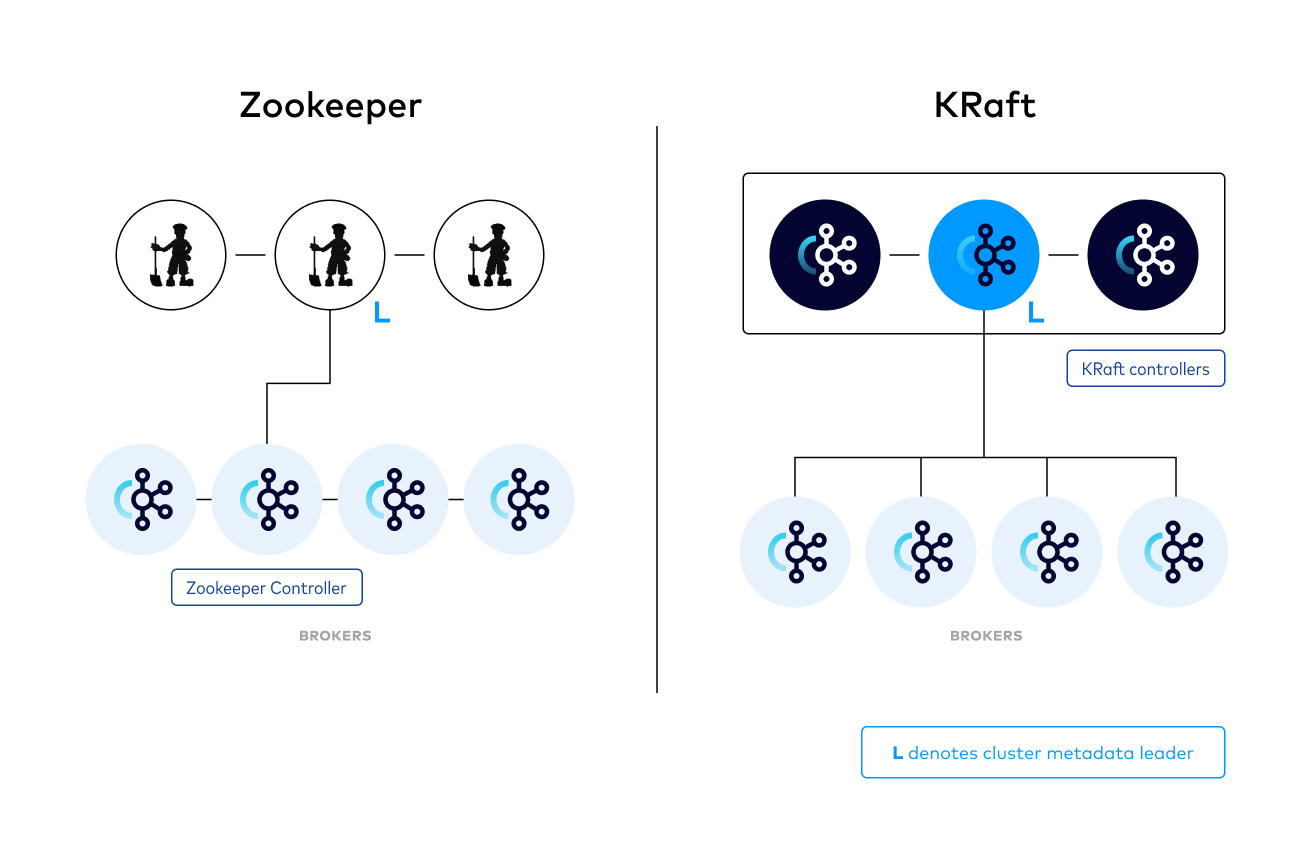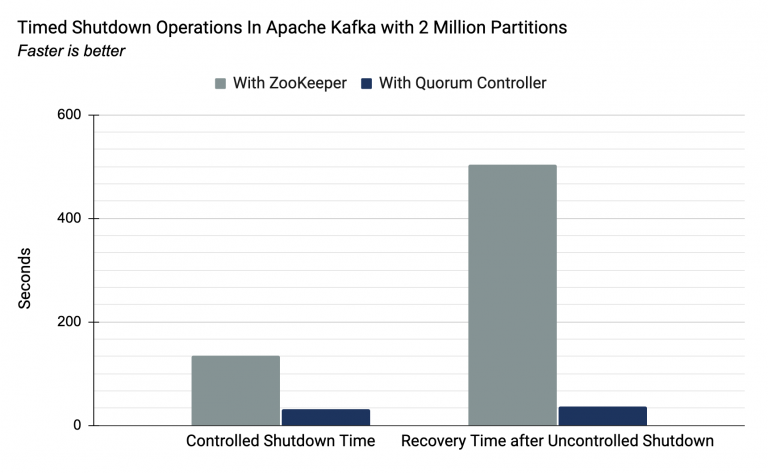KRaft Overview
Previously, when you ran Confluent Platform, you also always ran ZooKeeper for metadata storage. Starting with Confluent Platform version 7.4, KRaft (pronounced craft) mode is generally available.
Apache Kafka® Raft (KRaft) is the consensus protocol that was introduced to remove Kafka’s dependency on ZooKeeper for metadata management. This greatly simplifies Kafka’s architecture by consolidating responsibility for metadata into Kafka itself, rather than requiring and configuring two different systems: ZooKeeper and Kafka.
The following image provides a simple illustration of the difference between running with ZooKeeper and KRaft for managing metadata.

Note: This shows KRaft running in Isolated Mode
Why move to KRaft?
Moving to KRaft for metadata storage simplifies Kafka. ZooKeeper is a separate system, with its own configuration file syntax, management tools, and deployment patterns, which makes deploying Kafka more complicated for system administrators. Specifically:
KRaft enables right-sized clusters, meaning clusters that are sized with the appropriate number of brokers and compute that satisfies a use-case’s throughput and latency requirements, to scale up to millions of partitions.
Metadata failover is near-instantaneous with KRaft.
KRaft provides a single system to manage since KRaft is part of Kafka itself. Single management model for authentication, configuration, protocols, and networking.
The controller quorum
The KRaft controller nodes comprise a Raft quorum which manages the Kafka metadata log. This log contains information about each change to the cluster metadata. Everything that is currently stored in ZooKeeper, such as topics, partitions, ISRs, configurations, and so on, is stored in this log.
Using the Raft consensus protocol, the controller nodes maintain consistency and leader election without relying on any external system. The leader of the metadata log is called the active controller. The active controller handles all RPCs made from the brokers. The follower controllers replicate the data which is written to the active controller, and serve as hot standbys if the active controller should fail. With the concept of a metadata log, brokers use offsets to keep track of the latest metadata stored in the KRaft controllers, which results in more efficient propagation of metadata and faster recovery from controller failovers.
Just like ZooKeeper, KRaft requires a majority of nodes to be running. For example, a three-node controller cluster can survive one failure. A five-node controller cluster can survive two failures, and so on.
Periodically, the controllers will write out a snapshot of the metadata to disk. This is conceptually similar to compaction, but state is read from memory rather than re-reading the log from disk.
Scaling Kafka with KRaft
There are two properties that determine the number of partitions an Kafka cluster can support: the per-node partition count limit and cluster-wide partition limit. Previously, metadata management with ZooKeeper was the main bottleneck for the cluster-wide limitation. KRaft mode is designed to handle a much larger number of partitions per cluster, however Kafka’s scalability still primarily depends on adding nodes to get more capacity, so the cluster-wide limit still defines the upper bounds of scalability within the system.
With ZooKeeper, the upper bound of partitions was approximately 200,000, with the limiting factor being the time taken to move critical metadata between external consensus (ZooKeeper) to internal leader management (the Kafka controller). In KRaft, the new quorum controller serves both these roles. The result of this change is a near-instantaneous controller failover. The following image shows the results of a Confluent lab experiment on a Kafka cluster running 2 million partitions, which is 10 times the maximum number of partitions for a cluster running ZooKeeper. The experiment shows that controlled shutdown time and recovery time after uncontrolled shutdown are greatly improved with a quorum controller versus ZooKeeper.

Configuring Confluent Platform with KRaft
For details on how to configure Confluent Platform with KRaft, see Configure KRaft in Production.
Client configurations are not impacted by Confluent Platform moving to KRaft to manage metadata.
Limitations and known issues
Currently, migration from ZooKeeper to KRaft is not supported for Confluent Platform. You should choose how metadata is managed when you create an Kafka cluster.
Combined mode, where a Kafka node acts as a broker and also a KRaft controller, is not currently supported for production workloads. There are key security and feature gaps between combined mode and isolated mode in Confluent Platform.
Multi-Region Clusters using KRaft are currently not supported.
JBOD (just a bunch of disks) is not supported in KRaft mode, meaning you can only configure one directory for log.dirs configuration.
Source-initiated Cluster Linking for Confluent Platform between a source cluster running Confluent Platform 7.0.x or earlier and a destination Confluent Platform cluster running in KRaft mode is not supported. Source-initiated link creation may succeed, but the connection will ultimately fail. To work around this issue, make sure the source cluster is running Confluent Platform 7.1.0 or later; or use a default cluster link, not a source-initiated link. To avoid this issue if you have source-initiated links from a Confluent Platform source cluster to a Confluent Cloud destination cluster, you must upgrade your source clusters to Confluent Platform 7.1.0 or later, or use a default cluster link instead.
Authentication using delegation tokens or SASL SCRAM (Salted Challenge Response Authentication Mechanism) is currently not supported.
There is currently no support for quorum reconfiguration, meaning you cannot add more KRaft controllers, or remove existing ones.
You cannot currently use Topic ACL Authorizer for Schema Registry with|cp| in KRaft mode. As an alternative, you can use Schema Registry ACL Authorizer or Configuring Role-Based Access Control for Schema Registry.
Currently, Confluent Control Center (Legacy) and Health+ report KRaft controllers as brokers and as a result, alerts may not function as expected.
You may need to set the Self-Balancing option for Automatically improve cluster balance twice when you set it with Control Center (Legacy). For more information, see Using Control Center (Legacy).